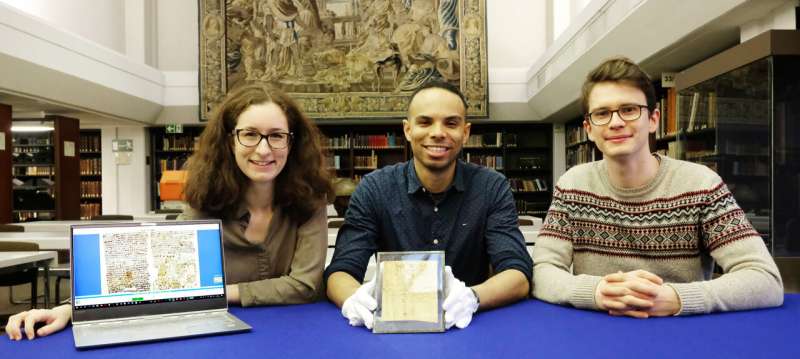This article has been reviewed according to Science X's editorial process and policies. Editors have highlighted the following attributes while ensuring the content's credibility:
fact-checked
trusted source
proofread
Love and hate in ancient times: New anthology on 'magical' texts published

"Magical" texts from Egypt in Coptic script and language are at the center of a research project at the University of Würzburg. They have now been collected and scientifically annotated for the first time in a 600-page book.
A team of scholars spent five years studying "magical" texts from Egypt that were written on papyrus, parchment, paper and shards of clay—so-called ostraca—and date from the period between the 4th and 12th centuries AD. Worn in an amulet around the neck or secretly hidden in the house of an adversary, the texts were supposed to heal illnesses, curse enemies, evoke love or hatred or allow a glimpse into the future, among other things.
What these texts also have in common is that they were all written in Coptic script and language. Coptic is the last stage in the development of the Egyptian language. It replaced Demotic around the 2nd century A.D. and was itself gradually replaced with the Arab conquest of Egypt in the 7th century.
Five years of research
"Papyri Copticae Magicae" is the title of the book. The scholars of antiquity Dr. Korshi Dosoo and Markéta Preininger are responsible for the publication. At the Chair of Egyptology at Julius-Maximilians-Universität Würzburg (JMU), the two have led the research project of the same name for the past five years.
"Around 600 of these texts have survived, but the largest published collection to date only contains around 100 of them. The rest were previously scattered in numerous books and articles and were therefore only accessible and known to a few specialists," says Korshi Dosoo, describing the initial situation of the project.
Love spells and separation wishes
The content of these texts can be categorized into a handful of categories. For example, they deal with protection from death or demons, the appeasement of enemies or the fulfillment of specific wishes. Love spells are a frequently found genre; they were mainly used by men. In some cases, the spell was intended to ensure that married couples separated again. Magic played an important role in medicine, for example, to prevent fever, headaches and insomnia. It was not uncommon for the papyrus to help its wearer become pregnant.
"These documents serve as an important source of information about popular religion—the reality, rather than the ideal, of religious practices and beliefs as they were lived and practiced in everyday life," explains Markéta Preininger Svobodova.
They thus provide today's readers with information about the experiences of people on the threshold of the transition from traditional Egyptian religion to Christianity and Islam, about their ideas of the human and divine world and about how human experiences such as happiness and success, suffering and illness, love and conflict were understood and negotiated. "These texts give us a direct insight into people's private lives at the time; they convey their true emotions," says the researcher.
The transition to Christianity leaves its mark
In fact, this transition to Christianity also left its mark on the magical texts. "The Christianization of Egypt ended the cults of the numerous gods of the pharaonic period, but it did not end the belief in a world full of superhuman powers," explains Korshi Dosoo. Instead, people transformed their former gods into angels and saints who served the almighty God and into evil beings who wanted to harm his creation.
Accordingly, these manuscripts are "rich sources of information about daily life and religion in Egypt in the last centuries of Roman rule and the first centuries after the Arab conquest," as the publisher writes.
Closing a gap in the research landscape
With their interest in magical texts from Egypt, the Würzburg research team is following in a long tradition. As early as 1928, the papyrologist Karl Preisendanz published the collection of texts Papyri Graecae Magicae (PGM), which, despite its name, essentially contained papyri from Egypt and was later supplemented by the Papyri Demoticae Magicae.
However, a comprehensive collection of magical texts in Coptic script and language had been lacking until now. "Thanks to JMU funding, Korshi Dosoo and Markéta Preininger have been able to begin to close this gap with the volume that has now been published," explains Professor Martin Andreas Stadler, Chair of Egyptology at JMU.
Continuation of the project is secured
Markéta Preininger and Korshi Dosoo and their team worked on the volume for five years; the Coptic Magical Papyri research project was completed a few weeks ago. However, the pair's work on the magical texts is far from over. Volume 1 could be followed by several more—"presumably seven," estimates Korshi Dosoo.
And at least volume 2 already seems to be assured. The two scientists recently learned that their application to the German Research Foundation (DFG) has been approved. With this financial support, they can now tackle a new project: the Corpus of Coptic Magical Formularies. Over the next three years at the University of Würzburg, they will continue to study love and hate, curses and wishes and all kinds of emotions from a bygone era.
More information: Korshi Dosoo et al, Papyri Copticae Magicae (2023). DOI: 10.1515/9783111080109
Provided by Julius-Maximilians-Universität Würzburg


















